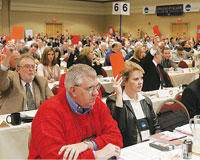NCAA News Archive - 2006
« back to 2006 | Back to NCAA News Archive Index
|
The NCAA News
Division II proposals at the 2006 NCAA Convention met one of two fates: They were approved overwhelmingly or, in two cases, they were sent back to the drawing board.
In a lighting-fast business session January 9, delegates approved 37 proposals either by a show of paddles or by pluralities of 90 percent or more. The only two votes that were close — Proposal Nos. 31 and 34 — both were defeated. The business session took only two and one-half hours, and voting on the 39 proposals (one was withdrawn on the Convention floor) was accomplished in one hour and 56 minutes.
All of the seven proposals in the Presidents Council grouping romped to approval. The “closest” of them was No. 22, which creates new academic requirements for student-athletes transferring to Division II institutions with only one year of eligibility remaining. That proposal passed by a count of 247-10-1.
In the Presidents Council grouping, the membership also approved legislation that will: n Establish penalties for institutions that fail to complete a self-study report within the required five-year period.
n Permit the name, picture or appearance of a student-athlete to be used in institutional, educational or nonprofit promotions that involve a commercial entity, under certain conditions.
n Permit an institution to advertise and upgrade its home facility, even if it is also the home facility for prospective student-athletes.
n Create an appropriate penalty structure that will strongly discourage the use of ineligible student-athletes in Division II regular- and postseason competition.
Until Proposal No. 31, there was no debate on the floor as legislation was moved, seconded, supported and voted upon. No. 31, however, revealed a divide about whether financial aid should be written for the academic year and the following summer, if the institution chooses to do so.
Supporters of the proposal, which was developed by the Legislation Committee and sponsored by the Presidents Council, said the legislation would permit student-athletes to better plan their academic calendars, including the summer terms.
But Kentucky State University Athletics Director Derita Ratcliffe spoke against the proposal, saying the provision of such aid could be used as a recruiting tool against institutions that can’t afford it, a sentiment echoed by Clint Bryant, athletics director at
The proposal failed by a vote of 113-141-5, representing a rare reversal for the Division II Student-Athlete Advisory Committee, which supported the change.
Another SAAC-backed proposal went down a few minutes later when delegates defeated No. 34. That debate was a bit edgier as the proposal became a question of what boundaries exist for out-of-season individual and team instruction.
The proposal would have permitted student-athletes and members of the coaching staff to engage in countable athletically related activities outside the institution’s playing season in sports other than football. Megan Burd of
Others, however, saw the issue differently.
Ed Harris, athletics director at
With such arguments against student-athlete time encroachment leading the way, the proposal went down, 103-152-3.
The twin defeats of Nos. 31 and 34 represented unusual setbacks for the Division II SAAC, which has had an almost uninterrupted string of legislative successes at recent Conventions.
SAAC Chair John Semeraro said the committee was frustrated after the vote and left wondering why the potential academic benefits of No. 31 did not trump the perceived recruiting liabilities. On No. 34, he disputed assertions that the extension of practice time was not student-athlete friendly when the student-athletes themselves said they were comfortable with the concept.
However,
“That’s OK,” Martin said. “Everything we want or support doesn’t always pan out. The administrators have to look at the issues from a number of perspectives, including budget, monitoring for rules compliance and staffing. And in any case, these issues probably will resurface in the future.”
The only other proposal to spark any other meaningful debate was No. 37, which will permit an institution to conduct a one-hour walk-through per day during the five-day acclimatization period, provided protective equipment is not worn and football equipment (footballs, blocking sleds and so on) is not used.
Harris, noting that the current rule was passed as part of the recent out-of-season conditioning model, said he would prefer to see research before accepting the change. But SAAC member Cory Cangelosi of the
On that issue, the SAAC position prevailed.
© 2010 The National Collegiate Athletic Association
Terms and Conditions | Privacy Policy

